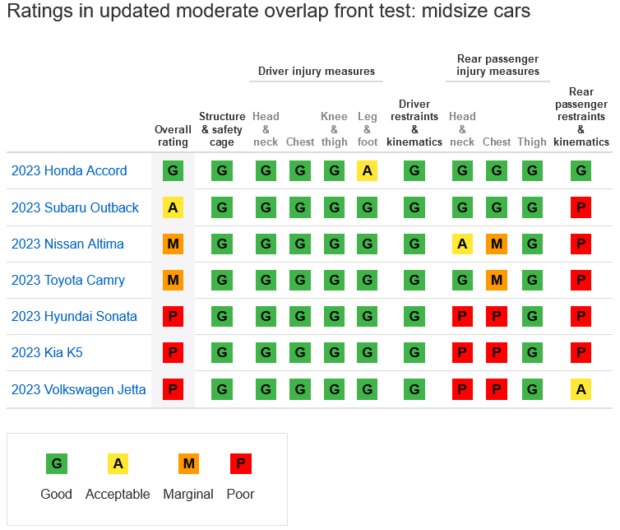New analysis released by the Insurance Institute for Highway Safety (IIHS) highlights a known safety issue with rear seats—submarining beneath the lapbelt—putting a passenger at risk for internal injuries.
To encourage manufacturers to improve rear seat protection, the IIHS launched an updated crash test adding a dummy in the back seat behind the driver.
The driver dummy is the size of an average adult male.
The rear dummy is the size of a small female or 12-year-old child.
Safety agency researchers also developed new metrics that focus on the injuries most frequently seen in backseat passengers.
For a vehicle to earn a good rating, there can’t be an excessive risk of injury to the head, neck, chest or thigh, as recorded by the second-row dummy, the IIHS stated.
The dummy should remain correctly positioned during the crash without submarining.
The head should also remain a safe distance from the front seatback and the rest of the vehicle interior, the IIHS stated, and the shoulder belt should remain on the shoulder.
A pressure sensor on the rear dummy’s torso is used to check the shoulder belt position during the crash.
As in the original test, the IIHS states that the structure of the occupant compartment must maintain adequate survival space for the driver, and measurements taken from the driver dummy shouldn’t show an excessive risk of injuries.
All seven midsize cars offered good protection in the front seat.
The Honda Accord outperformed other midsize cars in the updated moderate overlap front crash test, earning a rare good rating in the new, challenging evaluation focused on rear seat protection.
Among the other six midsize cars tested, the Subaru Outback earns an acceptable rating. The Nissan Altima and Toyota Camry are rated marginal. The Hyundai Sonata, Kia K5 and Volkswagen Jetta are rated poor.

“In most of the midsize cars we tested, the rear dummy slid forward, or ‘submarined,’ beneath the lap belt, causing it to ride up from the pelvis onto the abdomen and increasing the risk of internal injuries,” IIHS President David Harkey said. “In the three poor-rated vehicles, measurements taken from the rear dummy also indicated likely injuries to the head or neck as well as to the chest.”
There was a slightly higher risk of injuries to the right leg or foot of the driver in the good-rated Accord, while the vehicle proved stellar in providing back seat protection.
Measurements taken from the rear dummy showed no heightened risk of injuries and the rear restraints did a good job controlling the dummy’s motion, researchers noted.
Submarining was a problem for the poor-rated K5 and Sonata, while the Jetta the rear passenger’s head came too close to the front seat back.
Measurements taken from the rear dummy in all three poor-rated cars indicated likely injuries to the head or neck and chest and excessive belt forces.
In the K5 and Sonata, the rear shoulder belt also moved off the shoulder toward the neck, the researchers added.
In both the marginal-rated Altima and Camry, the rear dummy submarined beneath the lap belt, the IIHS stated, adding that the shoulder belt moved off the shoulder toward the dummy’s neck.
In the Altima, injury analysis also indicated a moderate risk of head or neck injuries for the rear passenger.
Measurements taken from the rear dummy in the acceptable-rated Outback didn’t show any elevated injury risks, though the crash dummy did submarine beneath the lap belt, whiledits head came close to the front seat back during the crash, increasing the likelihood of abdominal and head injuries, the researchers stated.
The dummy’s head also slipped between the side curtain airbag and contacted the rear window door trim as the dummy rebounded after the impact.





















 The Hardest Part of Innovation in Insurance Isn’t Technology; It’s Culture
The Hardest Part of Innovation in Insurance Isn’t Technology; It’s Culture  AI in Property/Casualty Insurance: Why Trusted Data Is the Missing Link
AI in Property/Casualty Insurance: Why Trusted Data Is the Missing Link  What to Expect in 2026: U.S. P/C Results More Like 2024
What to Expect in 2026: U.S. P/C Results More Like 2024  Rebuilding Negotiation Talent: Why This Skill Is Missing and How to Fix It
Rebuilding Negotiation Talent: Why This Skill Is Missing and How to Fix It 